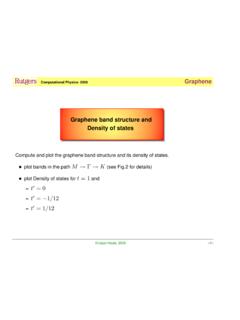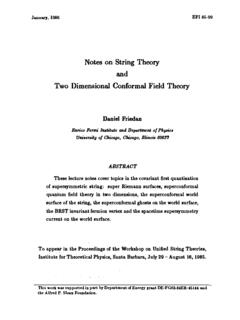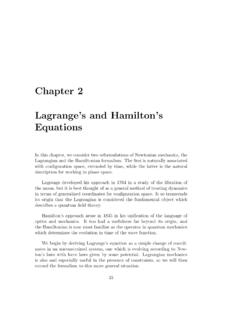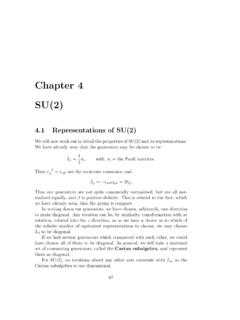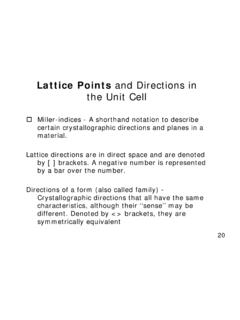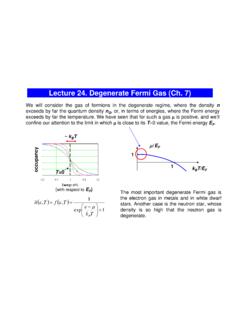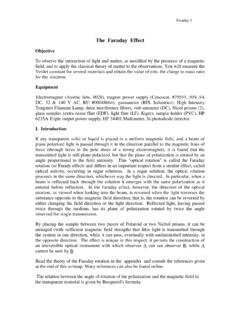Transcription of Supporting Information - Rutgers Physics & Astronomy
1 Supporting Information Wiley-VCH 201469451 Weinheim, GermanyMagnetic-Structure-Stabilized Polarization in an Above-Room-Temperature Ferrimagnet**Man-Rong Li, Maria Retuerto, David Walker, Tapati Sarkar, Peter W. Stephens,Swarnakamal Mukherjee, Tanusri Saha Dasgupta, Jason P. Hodges, Mark Croft,Christoph P. Grams, Joachim Hemberger, Javier S nchez-Ben tez, Ashfia Huq, Felix O. Saouma,Joon I. Jang, and Martha Greenblatt* Supporting INFORMATIOIN Full Information of References [3], [4], [7] and [13a]: [3] J. Wang, J. B. Neaton, H. Zheng, V. Nagarajan, S. B. Ogale, B. Liu, D. Viehland, V. Vaithyanathan, D. G. Schlom, U. V. Waghmare, N. A. Spaldin, K. M. Rabe, M. Wuttig, R. Ramesh, Science 2003, 299, 1719-1722 [4] N. Ikeda, Ohsumi, K. Ohwada, K. Ishii, T. Inami, K. Kakurai, Y. Murakami, K. Yoshii, S. Mori, Y. Horibe, H. Kit , Nature 2005, 436, 1136-1138.
2 [7] T. Varga, A. Kumar, E. Vlahos, S. Denev, M. Park, S. Hong,T. Sanehira, Y. Wang, C. J. Fennie, S. K. Streiffer,X. Ke, P. Schiffer, V. Gopalan, & J. F. Mitchell, Phys. Rev. Lett. 2009, 103, 047601. [13a] M. R. Li, D. Walker, M. Retuerto, T. Sarkar, J. Hadermann, P. W. Stephens, M. Croft, A. Ignatov, C. P. Grams, J. Hemberger, I. Nowik, P. S. Halasyamani, T. T. Tran, S. Mukherjee, T. Saha-Dasgupta, M. Greenblatt, Angew. Chem. 2013, 125, 8564-8568; Angew. Chem. Int. Ed. 2013, 52, 8406-8410. 2 Content 1. Cation Ordering in Corundum Derivatives 2. High Pressure Synthesis and Powder Synchrotron X-ray and Neutron Diffraction Studies 3. Second Harmonic Generation Measurements 4. X-ray Absorption Near-Edge Spectroscopy 5. Magnetic, Magnetotransport, and Electrical Conductivity Properties Measurements 6. Theoretical Calculations 7.
3 Dielectric and Polarization Measurements 1. Cation Ordering in Corundum Derivatives The crystal structure of corundum-type (A2O3) oxides consists of hexagonal close packing of the oxygen atoms, where the metal atoms occupy two-thirds of the octahedral sites, the remaining one-third of the octahedral sites are vacant (Fig. S1a).1-3 Each AO6 octahedron shares edges with three other AO6 octahedra to form an intralayer edge-sharing (ES) infinite sheet in the ab plane which is 2/3 occupied and 1/3 vacant. The intralayer ES octahedral sheets are bonded to form a three-dimensional structure via interlayer face-sharing (FS) to form octahedral pairs along the c direction, these pairs corner share with the edge-sharing slabs of alternative layers. The metal atoms near the center of FS octahedral pairs tend to displace away in opposite directions towards the vacant sites in order to reduce the electrostatic repulsions.
4 3 (a) Corundum (R-3c)(b) Ilmenite (R-3)(c) LiNbO3(R3c)(d) Ordered ilmenite (R3)(e) Ni3 TeO6(R3)Intralayer ESInterlayer FSAO6/BO6BO6AO6A1O6/A2O6BO6/B O6A1A2A1O6/BO6A2O6/B O6 Fig. S1 Cation ordering tree in corundum-related phases with (a) A2O3-type corundum; (b) ABO3-type ilmenite; (c) ABO3-type LiNbO3; (d) A2BB O6-type ordered ilmenite, and (e) A2BB O6-type Ni3 TeO6 crystal structures viewed along the [110] direction. Octahedral color: carmine, AO6; purple, BO6; cyan, B O6. 4 Given the same corundum-type rhombohedral stacking of octahedra, different crystal structures can be derived when the octahedral metal sites are occupied by more than one distinct cation (similar to the double perovskite related A2BB O6). Fig. S1 shows the cation ordering tree in corundum-derived systems, including ilmenite (IL), LiNbO3 (LN), ordered IL (OIL), and Ni3 TeO6 type structures,2,4,5 where the FS octahedral pairs along the c axis are formed by two different cation octahedra.
5 The crystal structures are highly strained: stretched in the ab plane and compressed in the c direction due to the electrostatic repulsions between the cations across the ES and FS octahedral pairs, respectively. IL and LN type Structures The IL and LN structures have two distinct cation-orderings in ABO3. IL adopts a centrosymmetric R-3 space group, built by alternating ES AO6 and BO6 octahedral layers in the ab plane stacked via FS between unlike A and B cations (Fig. S1b). While in the non-centrosymmetric LN structure (R3c), the ES octahedral layers consist of both AO6 and BO6 octahedra to avoid intralayer ES between identical cations (Fig. S1c). The number of reports on related phases increased in the past years, but because of the requirement of relatively high pressures for their preparation, these systems are far less explored than normal ABO3 perovskites.
6 Ordered Ilmenite and Ni3 TeO6-type Structures The A2BB O6 system is more complex (than IL and LN ABO3), as an additional ordering parameter is introduced into the B-sites. The crystal structure transforms to either OIL or Ni3 TeO6 type. Generally, B has a higher oxidation state than B; A is typically a monovalent-to-trivalent cation. So far, only a few compounds have been reported in this system: Li2 GeTeO6 is 5 the only phase with OIL structure bearing some B-site cationic disorder, which results in Li2[( )B( )B ] Several Ni3 TeO6-type compounds were reported with A+2B4+B 6+O6,6 A2+2B2+B 6+O6,4,5 A2+2B3+B 5+O6,7 and A3+2B2+B 4+O6 8 formulae, all of which contain an ion with electronic configuration (n-1)d10ns0 such as Ge4+,8 Sb5+,7 and Te6+,4-6 at the B'-site. Compared with IL, the OIL (R3) has two crystallographically independent A cations (designated as A1 and A2).
7 The ES layers are formed by either A or B octahedra and the intralayer ordering gives cystallographically unlike neighbors in ES A1O6/A2O6 layers and ES BO6/B'O6 layers (Fig. S1d), respectively. The interlayer FS A1O6/B'O6 and A2O6/BO6 octahedral pairs form A1-B'-A2-B columns parallel to the c axis. As shown in Fig. S1d, the A cations displace away from their FS partner cations (A1-B'; A2-B) toward opposite directions along the c axis; this displacement is largely responsible for the two crystallographically different A-site positions due to the size and charge difference between B and B cations. The Ni3 TeO6 structure is a close derivate of the LN structure; compared with OIL it has additional intralayer octahedral ordering to avoid ES between like A or B cations, and thus forming alternative stacking of A1O6/BO6 and A2O6/B'O6 octahedral layers in the ab-plane (Fig.)
8 S1e). The cation ordering in corundum derivatives is complex and can be driven by many factors, including the cationic size and charge difference, structural tolerance factor (t), electron configuration, and synthesis condition. The larger the size or charge difference between the cations, the greater is the chance of ordering. The corundum-derived ABO3 and A2BB'O6 systems can be regarded as highly distorted perovskite-related structures with very small tolerance factor (t) values9, due to the unusually small size of A cations. The A-site 12-fold coordination of the ideal perovskite structure transforms to an octahedral 6-fold coordination. These structures are highly distorted and compact, most are metastable at ambient pressure and 6 often require very high pressure for their synthesis.
9 10-12 For example, some IL-type structures transform into LN-polymorphs under higher ,14 Another important effect on the cation ordering is the electronic configuration. For example, Mn2 FeMO6 (M = Nb5+ and Ta5+, d0 ,) adopt a polar LN structure,12 while Mn2Fe3+Sb5+O6 (Sb5+, d10) a non-polar IL structure. We believe the latter behavior is due to the absence of a second-order Jahn-Teller d0 cation at the B -sites, which favors distortion of the Generally, the cation ordering is affected by the competition and/or combination of several factors for the lowest energy of the system, and the real outcome can be complicated and subtle case by case. For example, both Bi2 FeCrO6 and Bi2 FeTiO6 were predicted to stabilize in the Ni3 TeO6 ,16 However, Bi2 FeCrO6 prepared under HP crystallizes in the LN structure (R3c),11 while Bi2 FeTiO6 has not been experimentally prepared 2.
10 High Pressure Synthesis and Powder Synchrotron X-ray and Neutron Diffraction Studies Polycrystalline Mn2 FeMoO6 was prepared from stoichiometric mixtures of MnO ( , Alfa Aesar), Fe ( , Alfa Aesar), Fe2O3 ( , Sigma Aldrich) and MoO3 ( Alfa Aesar) under high pressure. The oxide mixture was placed in a Pt capsule, pressurized typically over 8-12 hours, and reacted at 1623 K under 8 GPa for 30 minutes in a LaCrO3 heater inside a MgO crucible in a multi-anvil press,18 and then quenched to RT by turning off the voltage supply to the resistance furnace, which reduced the temperature to RT in a few seconds. The pressure is maintained during the temperature quenching and then decompressed in 8-12 hours. Powder synchrotron x-ray diffraction (PSXD) data were recorded on beam line X-16C ( = ) at the National Synchrotron Light Source (NSLS), Brookhaven National Laboratory (US).
